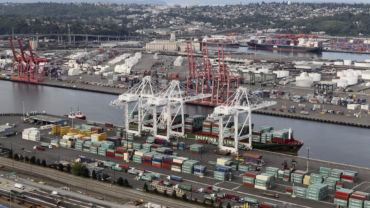This is the first in a two-part series on the difficulties increasingly faced by global supply chain companies, from growing responsibility over ESG issues from buyers to climate change challenges from suppliers
As the worst disfunctions of the pandemic begin to fade from the global supply chain (GSC), the firms which manage these chains have had little opportunity to rest. Multiple forces are building which will only add further challenges to the industry. And complicating factors have GSC companies facing pressure from all angles — from ESG-minded buyers and regulators to suppliers that are increasingly impacted by forces beyond their control.
Effectively flanked, GSC companies can no longer ignore ESG problems as they once have.
While the growing importance of environmental, social & governance (ESG) issues in the global supply chain has been long heralded, their ascent has been typically slow and often given lower priority over the core concerns of cost, timeliness, and ease of implementation. There are, however, signs that greater importance is being placed on these subjects today and that the sources of this importance may not accept delays. While business fundamentals are likely to always be the chief consideration, supply chain companies are increasingly facing an “all or nothing” approach to their operations, in which buyers and regulators alike force firms to deliver on all fronts.
Activist investors, those who heavily invest in a company in order to empower themselves to make changes, launched more campaigns in the first quarter of 2022 than in any since at least 2014. First time and smaller-cap focused funds also accounted for a higher proportion of activity than in prior years. These investors have had stunning victories over the last year against energy giants Exxon and Shell, seating multiple directors to push the oil & gas companies toward a carbon-neutral future. Such investors are increasingly pressuring companies to take stands and make hard decisions that those companies may otherwise prefer to avoid, be it traditional ESG concerns like global warming or the growing prevalence of social issues.
Retail investors, increasingly millennials and Gen Z consumers — some of whom are inheriting money from their more fiscally and politically conservative elders — also have displayed a greater appetite for ESG-minded companies, thus pressuring those companies to deliver or face an exodus of disappointed shareholders. While retail investing in stocks has declined over the last few months, the long-run forces that led to its rise (increasing accessibility, growing wealth and financial awareness among younger investors, the fear of missing out [FOMO], among others) are unlikely to abate so easily.
The end results of all of this is that, whether the managers of major companies share these ESG concerns or not, they have a growing disincentive to be associated with ESG failures in the supply chain. These companies will then move to distribute the risk to the supply chain providers in the form of certain provisions, such as contractual obligations, supplier codes of conduct, compliance with law provisions, and other legal requirements.
Pressure from governments
Ultimately, supply chain firms may have little choice regardless of the will of their clients. The passage of legislation in the US such as the Uyghur Forced Labor Prevention Act (with similar legislation being considered in Canada, the United Kingdom, Europe, and Australia) is forcing companies to tackle ESG concerns in their supply chain regardless of buyer-side pressures.
The US government’s investments of tens of millions of dollars (and a 2023 request for $70 million to pay for another 300 full-time positions in various regulatory agencies) indicates that regulators are serious about these concerns and intend to enforce these rules.
Such regulations, mandating immediate compliance, put GSC companies in a tough spot, as they will likely be forced to explore their own supply chains to a deeper degree than they had previously. Companies that have little transparency beyond the fourth or fifth layer of their supply chain could find themselves playing a twisted version of Minesweeper with very real dollars on the line should they find an infraction hiding within their chain. As such, there will likely be only increasing pressure on the supply chain coming from the buyer-side to fully map out what is an increasingly complex supply ecosystem.
Further, once firms begin to reach deep into their supply chains, they will find they have increasingly little power to influence their own suppliers unless firms can form wide-ranging, similarly goaled partnerships. Large companies such as Intel have found that suppliers residing multiple-layers deep into the supply chain — especially if they are separated by distance, nationality, and other factors — are extremely difficult to influence.
The kind of global partnerships that can overcome these barriers take time, effort, coordination, and some deal of luck to build. In short, they are not the kind of things that can be implemented in the few months between a law being passed and the full force of its consequences coming into effect.
So, what are GSC firms to do? The easy answer is to be ahead of the game and start charting their supply ecosystem now, while there is still time to do so. The harder answer is that firms may need to begin looking to build alternatives to the current hubs of risk they find within their supply chains. Of course, such endeavors are incredibly expensive, time consuming, and risky; and under normal circumstances, they would be the most unlikely courses of action.
Yet, there may be little choice. In the coming decades, GSC companies will have their hands full as they find climate change increasingly disruptive to their agricultural supply chain. This threat of climate change and the pressure it puts on GSC companies from the supply-side, however, may also provide the solution to this supply chain ecosystem problem they are facing.
In the next part of this series, we’ll examine how climate change has become a threat and a solution for GSC companies







